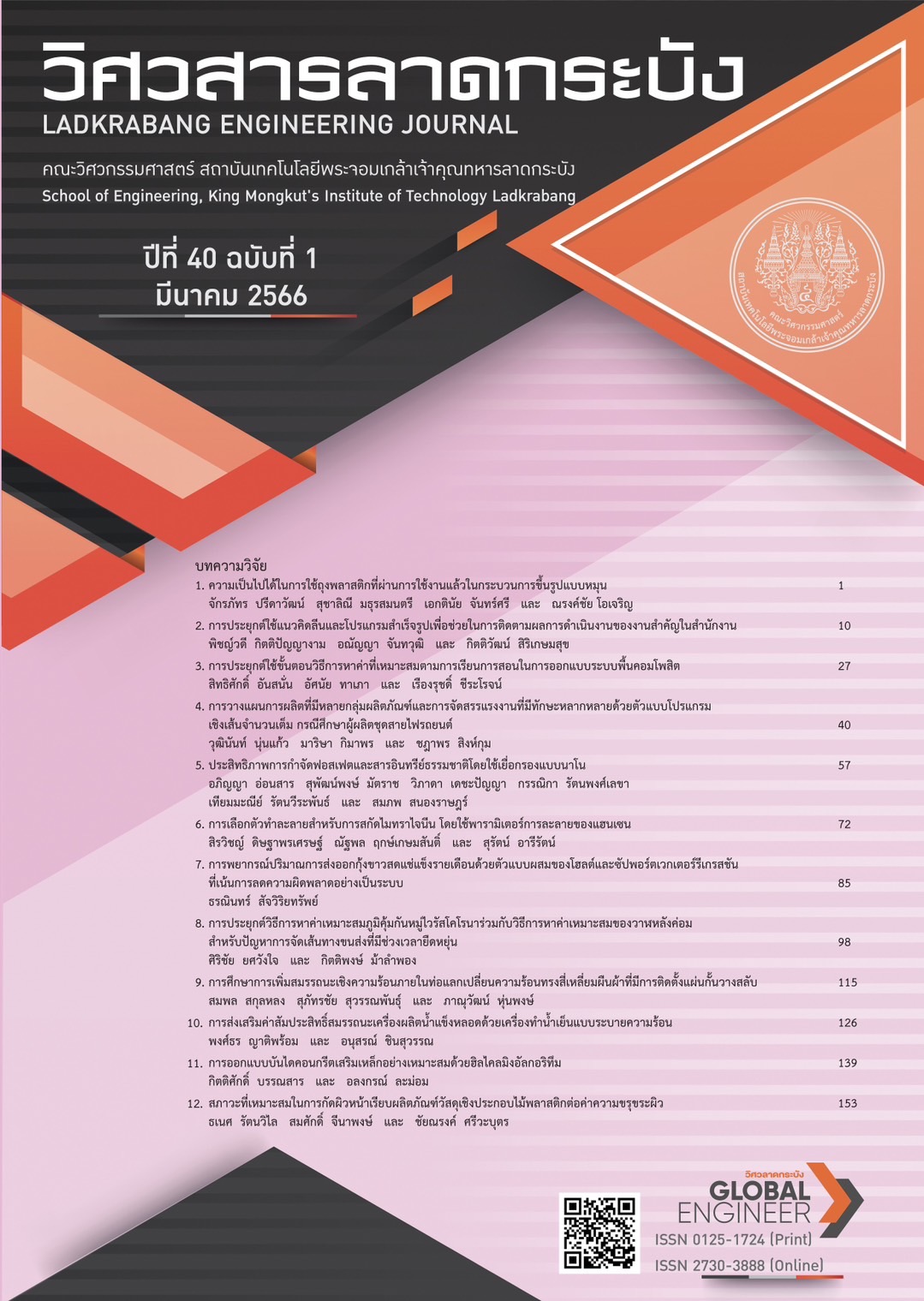Potential use of Recycled Plastic Bags in Rotational Molding Process
Keywords:
Plastic film, Polyethylene, Recycle, Rotational MoldingAbstract
Plastic bags are one of the most widely used products because it can provide convenience to users in everyday life. As a result, the amount of waste from plastic bags after use increases every year. The objective of this research is to study the preparation of used plastic bags to be in a suitable form for recycling by the rotational molding process. Including the study of various properties of molded products by using plastic bags that have been used in Pathum-Thani area, most of them are Low Density Polyethylene (LDPE) compared to Linear Low-Density Polyethylene (LLDPE) used in the rotational molding industry. In this research, the material for molding must be prepared by reducing the size of plastic bags to the powder particles by a Pulverizer, as well as measuring the particle size, roundness (Circularity) by morphological techniques. The pourability bulk density and melt flow index of the particles were tested and molded by an Axial Powder Flow Apparatus with the rotation speed at 7 rpm, temperature 190°C and recorded the behavior of changes within the mold and test the molded specimen by measuring the thickness distribution of the specimen, puncture resistance, tensile strength and surface hardness. It was found that the particle size of plastic powder prepared from plastic bags was larger and less roundness compared to the particle size of LLDPE powder used in the rotational molding industry. As a result, the thickness distribution of the workpieces produced with powder particles from plastic bags is inferior and the penetration resistance, tensile strength and surface hardness are reduced compared to using LLDPE.
References
P. J. Nugent and R. J. Crawford, “INTRODUCTION TO ROTATIONAL MOLDING,” in Rotational Molding of Plastics, New York, NY, USA: John Wiley and Sons lnc., 1992, ch. 1, sec. x, pp. 1–14.
J. Olinek, C. Anamd and C. T. Bellehumeur, “Experimental Study on the Flow and Deposition of Powder Particles in Rotational Molding,” Polymer Engineering and science, vol. 45, no. 1, pp.62–73, 2005, doi: 10.1002/pen.20230.
A. López Córdoba and S. Goyanes, “Food Powder Properties,” in Reference Module in Food Science, 2017, doi: 10.1016/b978-0-08-100596-5.21198-0.
A. Scoppio, D. Cavallo, A. J. Müller and D. Tranchida, “Temperature modulated DSC for composition analysis of recycled polyolefin blends,” Polymer Testing, vol. 113, 2022, Art. no. 107656, doi: 10.1016/j.polymertesting.2022.107656.
M. Bredács, C. Barretta, L. F. Castillon, A. Frank, G. Oreski, G. Pinter and S. Gergely, “Prediction of polyethylene density from FTIR and Raman spectroscopy using multivariate data analysis,” Polymer Testing, vol. 104, 2021, Art. no. 107406, doi: 10.1016/j.polymertesting.2021.107406.
lyondellbasell, “Molecular Structure and Composition Affect Properties and Processability,” in A Guide to Polyolefin Film Extrusion, Houston, TX, USA: LyondellBasell, 2015, ch. 3, pp.3–5.
B. I. Chaudhary, T. Elizabeth and V. John , “Processing enhancers for rotational molding of polyethylene,” Polymer Engineering and Science, vol. 41, no. 10, pp.1731–1742, 2001, doi: 10.1002/pen.10870.
Q. Fu, Y. Men and G. Strobl. “Understanding of tensile deformation in HDPE/LDPE blends based on their crystal structure and phase morphology,” Polymer, vol. 44, no. 6, pp. 1927–1933, 2003, doi: 10.1016/S0032-3861(02)00940-0.
C. N. Kartalis, C. D. Papaspyrides and R. Pfaedner. “Recycling of post-used PE packaging film using the restabilization technique,” Polymer Degradation and Stability, vol. 70, no. 2, pp.189–197, 2000, doi: 10.1016/S0141-3910(00)00106-3.
H. Jin, J. Gonzalez-Gutierrez, P. Oblak, B. Zupancic, and I. Emri, “The effect of extensive mechanical recycling on the properties of low density polyethylene,” Polymer Degradation and Stability, vol. 97, no. 11, pp. 2262–2272, 2012, doi: 10.1016/j.polymdegradstab.2012.07.039.
S. P. Cestari, P. J. Martin, P. R. Hanna, M. P. Kearns, L. C. Mendes and B. Millar, “Use of virgin/recycled polyethylene blends in rotational moulding,” Journal of Polymer Engineering, vol. 41, no. 6, pp. 509–516, 2021, doi: 10.1515/polyeng-2021-0065.
Downloads
Published
How to Cite
Issue
Section
License
Copyright (c) 2023 Faculty of Engineering, King Mongkut’s Institute of Technology Ladkrabang

This work is licensed under a Creative Commons Attribution-NonCommercial-NoDerivatives 4.0 International License.
The published articles are copyrighted by the School of Engineering, King Mongkut's Institute of Technology Ladkrabang.
The statements contained in each article in this academic journal are the personal opinions of each author and are not related to King Mongkut's Institute of Technology Ladkrabang and other faculty members in the institute.
Responsibility for all elements of each article belongs to each author; If there are any mistakes, each author is solely responsible for his own articles.






